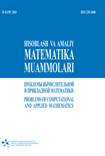Wiener–Hopf type system for finding optimal coefficients of difference formulas in the Hilbert space
Keywords:
Hilbert space, Cauchy problem, the extremal function, the error functional, optimal difference formulaAbstract
The optimization of computational methods in function spaces is one of the main problems in computational mathematics. In this work, using the variational method optimization of difference formulas for an approximate solution to the Cauchy problem is given. It is known that the errors of difference formulas are estimated from above using the norm of the error functional of these formulas. To find the norm of the error functional of difference formulas in explicit form, we will use the so-called extremal function of this functional. Here we will find the extremal function of this functional in a specific Hilbert space. A system of equations of the Wiener-Hopf type will be obtained by minimizing the squared norm of the error functional of difference formulas by coefficients. Next, we will prove the existence and uniqueness of a solution to this system.
References
Babu˘ska I., Vitasek E., Prager M. 1969. Numerical processes for solution of differential equations. - Mir, Moscow, – 369 p.
Babu˘ska I., Sobolev S. 1965. Optimization of numerical methods Apl. Mat. 10, – P. 9–170.
Sobolev S.L. 1974. Introduction to the theory of cubature formulas. Nauka, Moscow, – 808 p.
Sobolev S.L, Vaskevich V.L. 1996. Cubature formulas. Izdat. Inst. Mat., Novosibirsk, – 448 p.
Shadimetov Kh.M., Hayotov A.R. 2014. Optimal quadrature formulas in the sense of Sard in ????(????,????−1) 2 (0, 1) space, Calcolo, Springer, 51, – P. 211–243.
Shadimetov Kh.M. 2015. Functional statement of the problem of optimal difference formulas. Uzbek mathematical Journal, Tashkent, N. 4, – P. 179–183.
Shadimetov K.M., Mirzakabilov R.N. 2021. Optimization of difference methods in the Sobolev factor space. Problems of Computational and Applied Mathematics, 5(35), – P. 137–151.
Hayotov A.R., Karimov R.S. 2021. Optimal difference formula in the Hilbert space ????(2,1) 2 (0, 1). Problems of Computational and Applied Mathematics, 5(35), – P. 129–136.
Shadimetov K.M., Mirzakabilov R.N. 2022. Optimal Difference Formulas in the Sobolev Space. Contemporary Mathematics. Fundamental Directions. Vol. 68, N. 1, – P. 167–177.
Karimov R.S. 2022. An implicit difference formula for linear differential equation of the first order in the Hilbert space Problems of Computational and Applied Mathematics, 5/1(44), – P. 123–133.
Karimov R.S. 2022. A norm of an error functional of the optimal difference formula in the Hilbert space, Bulletin of the Institute of Mathematics, 5(5), – P. 46–52.
Kh.M. Shadimetov, A.R. Hayotov, R.S. Karimov 2023. Optimization of Explicit Difference Methods in the Hilbert Space ????(2,1) 2 , AIP Conference Proceedings, 2781, 00054.
Kh.M. Shadimetov, R.S. Karimov 2023. Coefficients of the optimal explicit difference formula in a Hilbert space, Problems of Computational and Applied Mathematics, 2/1(48), – P. 45–57.
Kh.M. Shadimetov, R.S. Karimov 2024. Optimization of Adams-type difference formulas in Hilbert space ????(2,1)
, Journal of Computational Analysis and Applications, 32(1), – P. 300—319.
Kh.M. Shadimetov, R.S. Karimov 2024. Optimal coefficients of an implicit difference formula in the Hilbert space, AIP Conference Proceedings, 3004, 060030.
K. Atkinson, W. Han 2009. Theoretical Numerical Analysis. Springer, 39, – 625 p.
Shadimetov Kh.M. 2019. Optimal lattice quadrature and cubature formulas in Sobolev spaces. Tashkent: Fan va Technology, – 224 p.
Shadimetov Kh.M., Khayotov A.R. 2022. Optimal approximation of error functionals of quadrature and interpolation formulas in spaces of differentiable functions. – Tashkent, Muhr Press, – 247 p.
Dahlquits G. 1956. Convergence and stability in the numerical integration of ordinary differential equations MATHEMATICA SCANDINAVICA, 4, – P. 33–53. https://doi.org/10.7146/math.scand.a-10454
Dahlquits G. 1959. Stability and error bounds in the numerical integration of ordinary differential equations, Trans. Roy. Inst. Technol., Stockholm, – 85 p.





